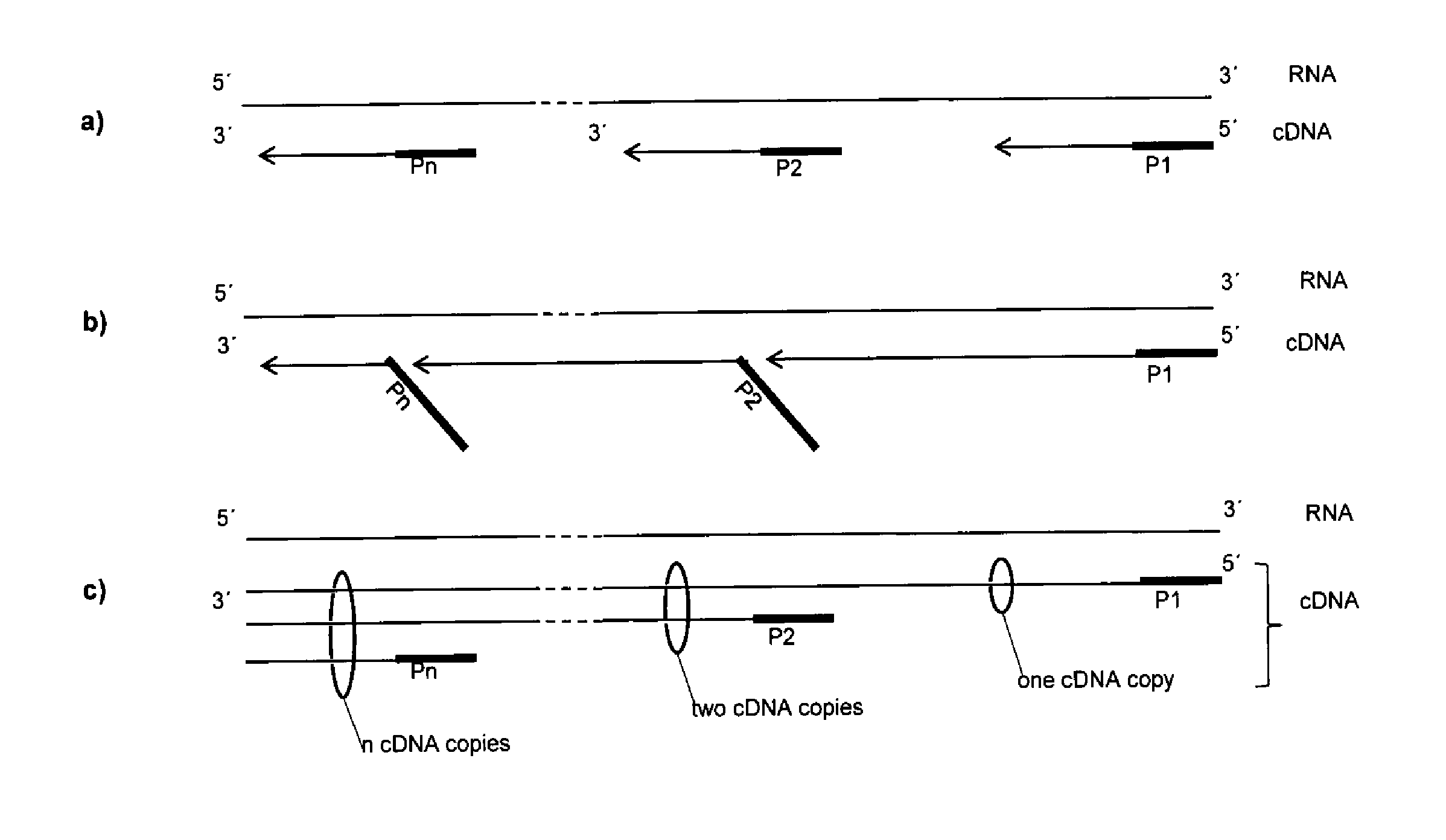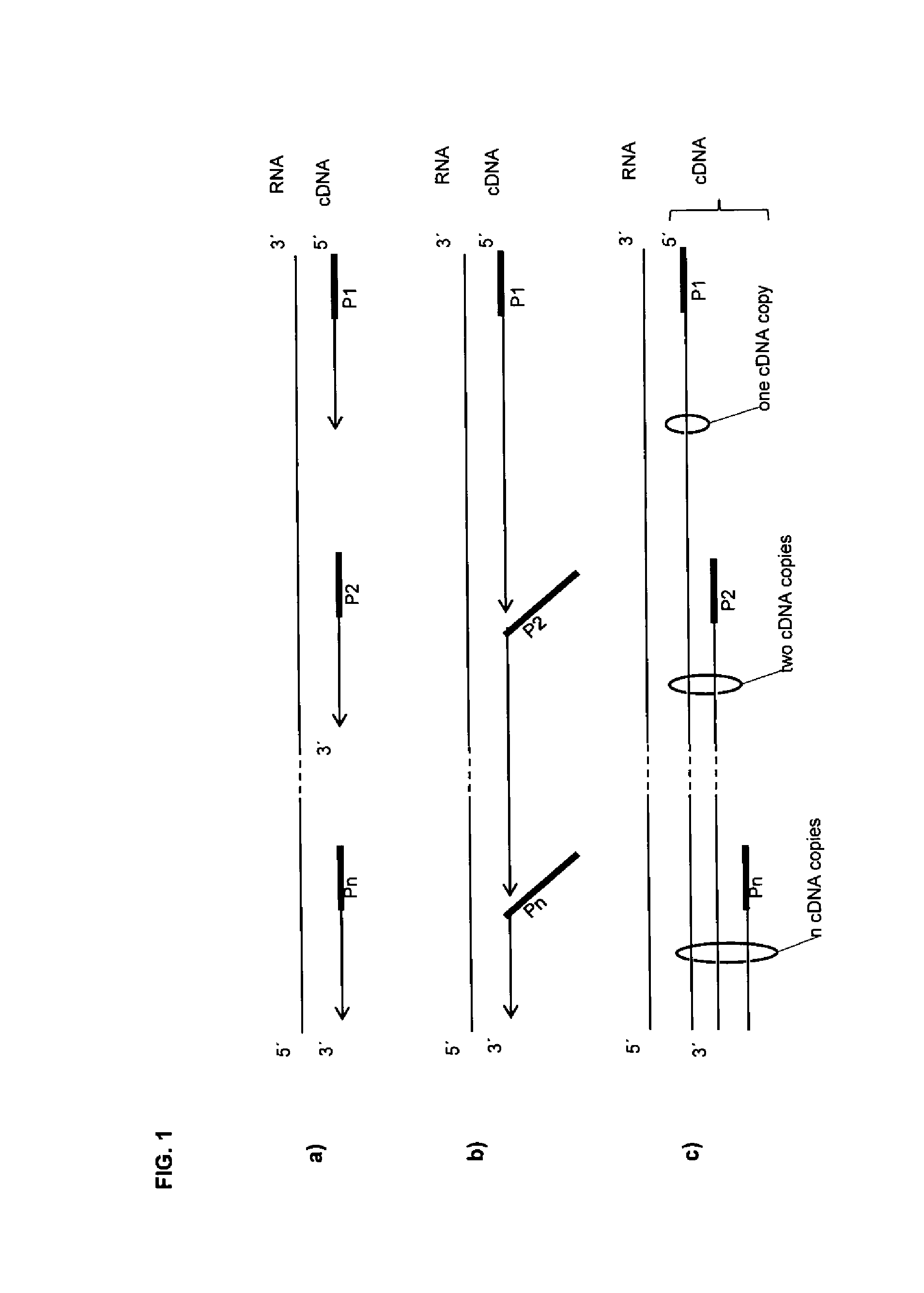Nucleic acid transcription method
a nucleic acid and transcription method technology, applied in the field of nucleic acid transcription methods, can solve the problems of strong overrepresentation of the 3′ end of the mrna, unsuitable pfuturbo dna polymerase, and limited use of template in the triamplification method, so as to improve the representation of the sequence concentration of the original template and less bias in the amplified amount
- Summary
- Abstract
- Description
- Claims
- Application Information
AI Technical Summary
Benefits of technology
Problems solved by technology
Method used
Image
Examples
example 1
Strand Displacement Stop of Reverse Transcriptases Using LNA Modified Oligonucleotides
[0177]
Sequences:SEQ ID No. 1: 5′-GCTAATACGACTCACTATAGTTGTCACCAGCATCCC-3′SEQ ID No. 2: 5′-TTTTTTTTTTTTTTTTTTTTTTTTTTTCGAATGGGCCGCAGGA-3′SEQ ID No. 3: 5′-GCTAATACGACTCACTATAGTTGTCACCAGCATCCCTAGACCCGTACAGTGCCCACTCCCCTTCCCAGTTTCCGACTGTCCCCGGCCTCCTGCGGCCCATTCGAAAAAAAAAAAAAAAAAAAAAAAAAAA-3′SEQ ID No. 4: 5′-guugucaccagcaucccuagacccguacagugcccacuccccuucccaguuuccgacuguccccggccuccugcggcccauucgaaaaaaaaaaaaaaaaaaaaaaaaaaa-3′ (RNA)SEQ ID No. 5: (Phos)(5′-+GGGCACTGTACG-3′)SEQ ID No. 6: (Phos)(5′-GGGCACTGTACG-3′)SEQ ID No. 7: (Phos)(5′-G*GGCACTGTAC*G-3′)SEQ ID No. 8: (Phos)(5′-+G+G+GCACTGTAC*G-3′)SEQ ID No. 9: 5′-A*CGGAGCCTATCTATATGTTCTTGACATTTTTTTTTTTTTTTTTTTTTTTTTT*T*V-3′SEQ ID No. 10: 5′-GGGCACTGTACGGGTCTAGGGATGCTGGTGACAAC-3′SEQ ID No. 11: 5′-A*CGGAGCCTATCTATATGTTCTTGACATTTTTTTTTTTTTTTTTTTTTTTTTTTCGAATGGGCCGCAGGAGGCCGGGGACAGTCGGAAACTGGGAAGGGGAGT-3′SEQ ID No. 12: 5′-A*CGGAGCCTATCTATATGTTCTTGACATTTTTTTTTTTTTTTTT...
example 2
cDNA Fragment Size Regulation
[0185]This example shows that the size of a cDNA library that is generated from mRNA can be regulated by the concentration of a random primer that stops an elongation reaction. For results see FIG. 11.
[0186]RNA Isolation and Purification:
[0187]Total RNA from mouse liver was isolated using PeqLab Gold columns in combination with acidic phenol extraction (PeqLab, PEQLAB Biotechnologie GMBH, D-91052 Erlangen) according to manufacturer's recommendation. The amount of RNA was measured by optical absorbance at 260 nm and checked for integrity on a formaldehyde agarose gel or an Agilent Bioanalyzer.
[0188]Terminator Treatment of Total RNA to Enrich for mRNAs:
[0189]2-5 μg of total RNA was treated with Terminator™ 5′-Phosphate-Dependent Exonuclease (Epicentre Biotechnologies, Madison, Wis. 53713), according to manufacturer's instructions.
[0190]cDNA Synthesis and Immunoblotting:
[0191]cDNA synthesis was carried out in 20 μl reactions with 50 mM Tris-HCl (pH 8.3 at 2...
example 3
Ligation Using an Artificial Template
[0195]The example shows that an extension product of a more upstream primer (P1) can be stopped by a more downstream primer (P2) that has three LNA modifications on its 5′ end and that the extension product of the upstream primer (P1) can by ligated to the downstream primer (P2) when all are in a hybrid with the template. For an overview of the sequences involved see FIG. 10a. For results see FIG. 12. Reverse transcription was carried out using oligos, template and conditions as described in Example 1.
[0196]After the RT the samples were ethanol precipitated and inserted into a 15 μl ligation reaction with 1 mM HCC, 20% PEG-8000, 30 mM Tris-HCl (pH 7.8 at 25° C.), 10 mM MgCl2, 10 mM DTT, 1 mM ATP and 1.5 μl of T4 DNA ligase (1-3 Weiss units / μl, Promega) and / or 1 μl of T4 RNA ligase 2 truncated (10 units / μl, NEB) and incubated 2 h at 37° C. Unligated small fragments and remaining oligos were removed by PEG precipitation. Therefore the volume of the...
PUM
| Property | Measurement | Unit |
|---|---|---|
| Fraction | aaaaa | aaaaa |
| Concentration | aaaaa | aaaaa |
| Length | aaaaa | aaaaa |
Abstract
Description
Claims
Application Information
 Login to View More
Login to View More - R&D
- Intellectual Property
- Life Sciences
- Materials
- Tech Scout
- Unparalleled Data Quality
- Higher Quality Content
- 60% Fewer Hallucinations
Browse by: Latest US Patents, China's latest patents, Technical Efficacy Thesaurus, Application Domain, Technology Topic, Popular Technical Reports.
© 2025 PatSnap. All rights reserved.Legal|Privacy policy|Modern Slavery Act Transparency Statement|Sitemap|About US| Contact US: help@patsnap.com



